Ad
Topic2IntroductionToJavaProgramming with concepts
- 1. CS305j Introduction to Computing Introduction to Java Programming 1 Topic 2 Introduction to Java Programming “When a programming language is created that allows programmers to program in simple English, it will be discovered that programmers cannot speak English.” - Anonymous Based on slides for Building Java Programs by Reges/Stepp, found at http://faculty.washington.edu/stepp/book/
- 2. CS305j Introduction to Computing Introduction to Java Programming 2 What We Will Do Today What are computer languages? Java editors – text editor and command line – BlueJ First programming concepts – output with println statements – syntax and errors structured algorithms with static methods identifiers, keywords, and comments
- 3. CS305j Introduction to Computing Introduction to Java Programming 3 Computers and Computer Languages Computers are everywhere – how many computers do you own? Computers are useful because they run various programs – program is simply a set of instructions to complete some task – how many different programs do you use in a day?
- 4. CS305j Introduction to Computing Introduction to Java Programming 4 Definitions program: A set of instructions that are to be carried out by a computer. program execution: The act of carrying out the instructions contained in a program. – this is done by feeding the instructions to the CPU programming language: A systematic set of rules used to describe computations, generally in a format that is editable by humans. – in this class will are using Java
- 5. CS305j Introduction to Computing Introduction to Java Programming 5 High Level Languages Computers are fast – Pentium 4 chip from 2001 can perform approximately 1,700,000,000 computations per second – made up of 42,000,000 transistors (a switch that is on or off) Computers are dumb – They can only carry out a very limited set of instructions • on the order of 100 or so depending on the computer's processor • machine language instructions, aka instruction set architecture (ISA) • Add, Branch, Jump, Get Data, Get Instruction, Store
- 6. CS305j Introduction to Computing Introduction to Java Programming 6 Machine Code John von Neumann - co-author of paper in 1946 with Arthur W. Burks and Hermann H. Goldstine, – "Preliminary Discussion of the Logical Design of an Electronic Computing Instrument" One of the key points – program commands and data stored as sequences of bits in the computer's memory A program: 1110001100000000 0101011011100000 0110100001000000 0000100000001000 0001011011000100 0001001001100001 0110100001000000
- 7. CS305j Introduction to Computing Introduction to Java Programming 7 Say What? Programming with Strings of bits (1s or 0s) is not the easiest thing in the world. Assembly language – mnemonics for machine language instructions .ORIG x3001 LD R1, x3100 AND R3, R3 #0 LD R4, R1 BRn x3008 ADD R3, R3, R4 ADD R1, R1, #1 LD R4, R1 BRnzp x3003
- 8. CS305j Introduction to Computing Introduction to Java Programming 8 High Level Languages Assembly language, still not so easy, and lots of commands to accomplish things High Level Computer Languages provide the ability to accomplish a lot with fewer commands than machine or assembly language in a way that is hopefully easier to understand int sum; int count = 0; int done = -1; while( list[count]!= -1 ) sum += list[count];
- 9. CS305j Introduction to Computing Introduction to Java Programming 9 Java There are hundreds of high level computer languages. Java, C++, C, Basic, Fortran, Cobol, Lisp, Perl, Prolog, Eiffel, Python The capabilities of the languages vary widely, but they all need a way to do – declarative statements – conditional statements – iterative or repetitive statements A compiler is a program that converts commands in high level languages to machine language instructions
- 10. CS305j Introduction to Computing Introduction to Java Programming 10 A Picture is Worth… The Interpreter's are sometimes referred to as the Java Virtual Machines The output of the compiler is .class file
- 11. CS305j Introduction to Computing Introduction to Java Programming 11 A Simple Java Program public class Hello { public static void main(String[] args) { System.out.println("Hello World!"); } } This would be in a text file named Hello.java DEMO of writing and running a program via notepad and the command line
- 12. CS305j Introduction to Computing Introduction to Java Programming 12 More Definitions code or source code: The sequence of instructions in a particular program. – The code in this program instructs the computer to print a message of Hello, world! on the screen. output: The messages printed to the computer user by a program. console: The text box or window onto which output is printed.
- 13. CS305j Introduction to Computing Introduction to Java Programming 13 Compiling and Running Compiler: a program that converts a program in one language to another language – compile from C++ to machine code – compile Java to bytecode Bytecode: a language for an imaginary cpu Interpreter: A converts one instruction or line of code from one language to another and then executes that instruction – When java programs are run the bytecode produced by the compiler is fed to an interpreter that converts it to machine code for a particular CPU – on my machine it converts it to instructions for a Pentium cpu
- 14. CS305j Introduction to Computing Introduction to Java Programming 14 The command line To run a Java program using your Command Prompt: change to the directory of your program cd compile the program javac Hello.java execute the program java Hello source code (Hello.java) compile byte code (Hello.class) execute output
- 15. CS305j Introduction to Computing Introduction to Java Programming 15 Another Java program public class Hello2 { public static void main(String[] args) { System.out.println("Hello, world!"); System.out.println(); System.out.println("This program produces"); System.out.println("four lines of output"); } } The code in this program instructs the computer to print four messages on the screen.
- 16. CS305j Introduction to Computing Introduction to Java Programming 16 Structure of Java programs public class <name> { public static void main(String[] args) { <statement(s)>; } } Every executable Java program consists of a class... – that contains a method named main... • that contains the statements to be executed The previous program is a class named Hello, whose main method executes one statement named System.out.println
- 17. CS305j Introduction to Computing Introduction to Java Programming 17 Java terminology class: (a) A module that can contain executable code. (b) A description of a type of objects. (seen later) statement: An executable piece of code that represents a complete command to the computer. – every basic Java statement ends with a semicolon ; method: A named sequence of statements that can be executed together to perform a particular action or computation.
- 18. CS305j Introduction to Computing Introduction to Java Programming 18 Syntax and syntax errors syntax: The set of legal structures and commands that can be used in a particular programming language. syntax error or compiler error: A problem in the structure of a program that causes the compiler to fail. – If you type your Java program incorrectly, you may violate Java's syntax and see a syntax error. public class Hello { pooblic static void main(String[] args) { System.owt.println("Hello, world!")_ } }
- 19. CS305j Introduction to Computing Introduction to Java Programming 19 Compiler Output The program on the previous slide produces the following output when we attempt to compile it H:summerHello.java:2: <identifier> expected pooblic static void main(String[] args) { ^ H:summerHello.java:5: ';' expected } ^ 2 errors Tool completed with exit code 1 compiler output:
- 20. CS305j Introduction to Computing Introduction to Java Programming 20 Fixing syntax errors Notice how the error messages are sort of cryptic and do not always help us understand what is wrong: H:summerHello.java:2: <identifier> expected pooblic static void main(String[] args) { ^ – We'd have preferred a friendly message such as, "You misspelled 'public' " The compiler does tell us the line number on which it found the error, which helps us find the place to fix the code. – The line number shown is a good hint, but is not always the true source of the problem. Java has a fairly rigid syntax.
- 21. CS305j Introduction to Computing Introduction to Java Programming 21 System.out.println Java programs use a statement called System.out.println to instruct the computer to print a line of output on the console – pronounced "print-linn"; sometimes called a println statement for short Two ways to use System.out.println : – 1. System.out.println("<Message>"); • Prints the given message as a line of text on the console. – 2. System.out.println(); • Prints a blank line on the console.
- 22. CS305j Introduction to Computing Introduction to Java Programming 22 Strings and string literals string: A sequence of text characters (not just letters) that can be printed or manipulated in a program. literal: a representation of a value of a particular type – String literals in Java start and end with quotation mark characters "This is a string"
- 23. CS305j Introduction to Computing Introduction to Java Programming 23 Details about Strings A string literal may not span across multiple lines. "This is not a legal String." A string may not contain a " character. ' is OK "This is not a "legal" String either." "This is 'okay' though." A string can represent certain special characters by preceding them with a backslash (this is called an escape sequence). – t tab character – n new line character – " quotation mark character – backslash character
- 24. CS305j Introduction to Computing Introduction to Java Programming 24 Practice Program 1 What sequence of println statements will generate the following output? This program prints the first lines of the song "slots". "She lives in a trailer" "On the outskirts 'a Reno" "She plays quarter slots in the locals casino."
- 25. CS305j Introduction to Computing Introduction to Java Programming 25 Practice Program 2 What sequence of println statements will generate the following output? A "quoted" String is 'much' better if you learn the rules of "escape sequences." Also, "" represents an empty String. Don't forget to use " instead of " ! '' is not the same as "
- 26. CS305j Introduction to Computing Introduction to Java Programming 26 Practice Program 3 What is the output of the following println statements? System.out.println("tatbtc"); System.out.println(""); System.out.println("'"); System.out.println("""""); System.out.println("C:ninthe downward spiral"); 26
- 27. CS305j Introduction to Computing Introduction to Java Programming 27 Answer to Practice Program 3 Output of each println statement: a b c ' """ C: in he downward spiral
- 28. CS305j Introduction to Computing Introduction to Java Programming 28 Practice Program 4 Write a println statement to produce this output: / // ///
- 29. CS305j Introduction to Computing Introduction to Java Programming 29 Answer to Practice Program 4 println statement to produce the line of output: System.out.println("/ // /// ");
- 30. CS305j Introduction to Computing Introduction to Java Programming 30 A structured example What sequence of println statements will generate the following output? _____ / / / _____/ _____ / / | | | | | | / _____/ _____ / / +-------+ _____ / / What observations can we make about the output that is generated? It has a noticeable structure. (draw first figure, draw second figure, draw third figure, ...) The output contains redundancy. Certain figures (or large parts of figures) are repeated in the output.
- 31. CS305j Introduction to Computing Introduction to Java Programming 31 Structured algorithms How does one bake sugar cookies? – Mix the dry ingredients. – Cream the butter and sugar. – Beat in the eggs. – Stir in the dry ingredients. – Set the oven for the appropriate temperature. – Set the timer. – Place the cookies into the oven. – Allow the cookies to bake. – Mix the ingredients for the frosting. – Spread frosting and sprinkles onto the cookies. – ... Can we express this process in a more structured way?
- 32. CS305j Introduction to Computing Introduction to Java Programming 32 A structured algorithm structured algorithm: A list of steps for solving a problem, which is broken down into cohesive tasks. A structured algorithm for baking sugar cookies: – 1. Make the cookie batter. • Mix the dry ingredients. • Cream the butter and sugar. • Beat in the eggs. • Stir in the dry ingredients. – 2. Bake the cookies. • Set the oven for the appropriate temperature. • Set the timer. • Place the cookies into the oven. • Allow the cookies to bake. – 3. Add frosting and sprinkles. • Mix the ingredients for the frosting. • Spread frosting and sprinkles onto the cookies. – ...
- 33. CS305j Introduction to Computing Introduction to Java Programming 33 Redundancy in algorithms How would we express the steps to bake a double batch of sugar cookies? Unstructured: Mix the dry ingredients. Cream the butter and sugar. Beat in the eggs. Stir in the dry ingredients. Set the oven ... Set the timer. Place the first batch of cookies into the oven. Allow the cookies to bake. Set the oven ... Set the timer. Place the second batch of cookies into the oven. Allow the cookies to bake. Mix the ingredients for the frosting. Structured: 1. Make the cookie batter. 2a. Bake the first batch of cookies. 2b. Bake the second batch of cookies. 3. Add frosting and sprinkles. Observation: A structured algorithm not only presents the problem in a hierarchical way that is easier to understand, but it also provides higher-level operations which help eliminate redundancy in the algorithm.
- 34. CS305j Introduction to Computing Introduction to Java Programming 34 Static methods static method: A group of statements that is given a name so that it can be executed in our program. – Breaking down a problem into static methods is also called "procedural decomposition." Using a static method requires two steps: – declare it (write down the recipe) • When we declare a static method, we write a group of statements and give it a name. – call it (cook using the recipe) • When we call a static method, we tell our main method to execute the statements in that static method. Static methods are useful for: – denoting the structure of a larger program in smaller, more understandable pieces – eliminating redundancy through reuse
- 35. CS305j Introduction to Computing Introduction to Java Programming 35 Static method syntax The structure of a static method: public class <Class Name> { public static void <Method name> () { <statements>; } } Example: public static void printCheer() { System.out.println(“Three cheers for Pirates!"); System.out.println(“Huzzah!"); System.out.println(“Huzzah!"); System.out.println(“Huzzah!"); }
- 36. CS305j Introduction to Computing Introduction to Java Programming 36 Static methods example public class TwoMessages { public static void main(String[] args) { printCheer(); System.out.println(); printCheer(); } public static void printCheer() { System.out.println(“Three cheers for Pirates!"); System.out.println(“Huzzah!"); System.out.println(“Huzzah!"); System.out.println(“Huzzah!"); } } Program's output: Three cheers for Pirates! Huzzah! Huzzah! Huzzah! Three cheers for Pirates! Huzzah! Huzzah! Huzzah!
- 37. CS305j Introduction to Computing Introduction to Java Programming 37 Methods calling each other One static method may call another: public class TwelveDays { public static void main(String[] args) { day1(); day2(); } public static void day1() { System.out.println("A partridge in a pear tree."); } public static void day2() { System.out.println("Two turtle doves, and"); day1(); } } Program's output: A partridge in a pear tree. Two turtle doves, and A partridge in a pear tree.
- 38. CS305j Introduction to Computing Introduction to Java Programming 38 Control flow of methods When a method is called, a Java program 'jumps' into that method, executes all of its statements, and then 'jumps' back to where it started. public class TwelveDays { public static void main(String[] args) { day1(); day2(); } } public static void day1() { System.out.println("A partridge in a pear tree."); } public static void day2() { System.out.println("Two turtle doves, and"); day1(); }
- 39. CS305j Introduction to Computing Introduction to Java Programming 39 Static method problems Write a program that prints the following output to the console. Use static methods as appropriate. I do not like green eggs and ham, I do not like them, Sam I am! I do not like them on boat, I do not like them with a goat. I do not like green eggs and ham, I do not like them, Sam I am! Write a program that prints the following output to the console. Use static methods as appropriate. Lollipop, lollipop Oh, lolli lolli lolli Lollipop, lollipop Oh, lolli lolli lolli Call my baby lollipop
- 40. CS305j Introduction to Computing Introduction to Java Programming 40 When to use static methods You should place a group of statements into a static method if any of the following conditions is met: – The statements are related to each other and form a combined part of the program's structure. – The statements are repeated in the program. You need not create static methods for the following: – Individual statements. (One single println in its own static method does not improve the program, and may make it harder to read.) – Unrelated or weakly related statements. (If the statements are not closely related, consider splitting the method into two or more smaller methods.) – Only blank lines. (It's fine to have blank System.out.println(); statements in the main method.) Remember, these are guidelines!
- 41. CS305j Introduction to Computing Introduction to Java Programming 41 Identifiers identifier: A name that we give to a piece of data or part of a program. – Identifiers are useful because they allow us to refer to that data or code later in the program. – Identifiers give names to: • classes • methods • variables (named pieces of data; seen later) The name you give to a static method is an example of an identifier. – What are some other example identifier we've seen?
- 42. CS305j Introduction to Computing Introduction to Java Programming 42 Details about identifiers Java identifier names: – first character must a letter or _ or $ – following characters can be any of those characters or a number – identifiers are case-sensitive; name is different from Name Example Java identifiers: – legal: olivia second_place _myName TheCure ANSWER_IS_42 $variable – illegal: me+u :-) question? side-swipe hi there ph.d belles's 2%milk [email protected] • explain why each of the above identifiers is not legal.
- 43. CS305j Introduction to Computing Introduction to Java Programming 43 Keywords keyword: An identifier that you cannot use, because it already has a reserved meaning in the Java language. Complete list of Java keywords: abstract default if private this boolean do implements protected throw break double import public throws byte else instanceof return transient case extends int short try catch final interface static void char finally long strictfp volatile class float native super while const for new switch continue goto package synchronized You may not use char or while or this or any other keyword for the name of a class or method; Java reserves those words to mean other things. – You could use CHAR, While, or ThIs, because Java is case-sensitive. However, this could be confusing and is not recommended.
- 44. CS305j Introduction to Computing Introduction to Java Programming 44 Comments comment: A note written in the source code by the programmer to make the code easier to understand. – Comments are not executed when your program runs. – Most Java editors turn your comments a special color to make it easier to identify them. Comment, general syntax: /* <comment text; may span multiple lines> */ or, // <comment text, on one line> Examples: – /* A comment goes here. */ – /* It can even span multiple lines. */ – // This is a one-line comment.
- 45. CS305j Introduction to Computing Introduction to Java Programming 45 Using comments Comments can be put in many standard places. – Most all programs have a "comment header" at the top of each file, naming the author and explaining what the program does. – Most programmers also place a comment at the start of every method, describing the method's behaviour. – Lastly, we can use comments inside methods to explain particular pieces of code. Comments provide important documentation. – At this stage in our learning, it is not very useful to write comments, because we only know println statements. – More complicated programs span hundreds or thousands of lines, and it becomes very difficult to remember what each method is doing. Comments provide a simple description. – When multiple programmers work together, comments help one programmer understand the other's code.
- 46. CS305j Introduction to Computing Introduction to Java Programming 46 Comments example /* Olivia Scott CS 305j, Fall 2006 This program prints lyrics from a song! */ public class PartOfSong { /* Runs the overall program to print the song on the console. */ public static void main(String[] args) { displayVerse(); // Separate the two verses with a blank line System.out.println(); displayVerse(); } // Displays the first verse of song. public static void displayVerse() { System.out.println("The road goes on forever,"); System.out.println("And the party never ends!"); } }
- 47. CS305j Introduction to Computing Introduction to Java Programming 47 How to comment: methods Write a comment at the top of each of your methods that explains what the method does. – You do not need to describe the Java syntax and statements in detail, but merely provide a short English description of the observed behavior when the method is run. – Example: // This method prints the lyrics to the first verse // of the TV theme song to the Fresh Prince of Bellaire. // Blank lines separate the parts of the verse. public static void verse1() { System.out.println("Now this is the story all about how"); System.out.println("My life got flipped turned upside-down"); System.out.println(); System.out.println("And I'd like to take a minute,"); System.out.println("just sit right there"); System.out.println("I'll tell you how I became the prince"); System.out.println("of a town called Bel-Air"); }
Editor's Notes
- #41: answer: the identifier 'main'







![CS305j Introduction to
Computing
Introduction to Java Programming 8
High Level Languages
Assembly language, still not so easy, and lots
of commands to accomplish things
High Level Computer Languages provide the
ability to accomplish a lot with fewer commands
than machine or assembly language in a way
that is hopefully easier to understand
int sum;
int count = 0;
int done = -1;
while( list[count]!= -1 )
sum += list[count];](https://image.slidesharecdn.com/topic2introductiontojavaprogramming-250208040731-d6f4ff4a/85/Topic2IntroductionToJavaProgramming-with-concepts-8-320.jpg)


![CS305j Introduction to
Computing
Introduction to Java Programming 11
A Simple Java Program
public class Hello
{ public static void main(String[] args)
{ System.out.println("Hello World!");
}
}
This would be in a text file named Hello.java
DEMO of writing and running a program via notepad and
the command line](https://image.slidesharecdn.com/topic2introductiontojavaprogramming-250208040731-d6f4ff4a/85/Topic2IntroductionToJavaProgramming-with-concepts-11-320.jpg)
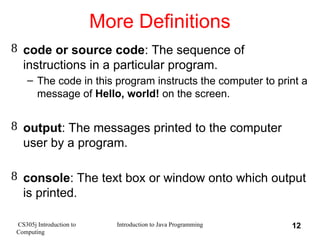
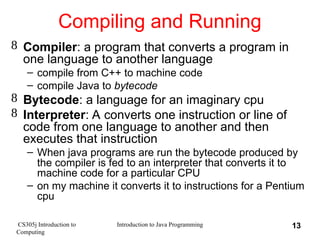

![CS305j Introduction to
Computing
Introduction to Java Programming 15
Another Java program
public class Hello2 {
public static void main(String[] args) {
System.out.println("Hello, world!");
System.out.println();
System.out.println("This program produces");
System.out.println("four lines of output");
}
}
The code in this program instructs the
computer to print four messages on the
screen.](https://image.slidesharecdn.com/topic2introductiontojavaprogramming-250208040731-d6f4ff4a/85/Topic2IntroductionToJavaProgramming-with-concepts-15-320.jpg)
![CS305j Introduction to
Computing
Introduction to Java Programming 16
Structure of Java programs
public class <name> {
public static void main(String[] args) {
<statement(s)>;
}
}
Every executable Java program consists of a
class...
– that contains a method named main...
• that contains the statements to be executed
The previous program is a class named
Hello, whose main method executes one
statement named System.out.println](https://image.slidesharecdn.com/topic2introductiontojavaprogramming-250208040731-d6f4ff4a/85/Topic2IntroductionToJavaProgramming-with-concepts-16-320.jpg)

![CS305j Introduction to
Computing
Introduction to Java Programming 18
Syntax and syntax errors
syntax: The set of legal structures and commands
that can be used in a particular programming
language.
syntax error or compiler error: A problem in the
structure of a program that causes the compiler to
fail.
– If you type your Java program incorrectly, you may
violate Java's syntax and see a syntax error.
public class Hello {
pooblic static void main(String[] args) {
System.owt.println("Hello, world!")_
}
}](https://image.slidesharecdn.com/topic2introductiontojavaprogramming-250208040731-d6f4ff4a/85/Topic2IntroductionToJavaProgramming-with-concepts-18-320.jpg)
![CS305j Introduction to
Computing
Introduction to Java Programming 19
Compiler Output
The program on the previous slide produces
the following output when we attempt to
compile it
H:summerHello.java:2: <identifier> expected
pooblic static void main(String[] args) {
^
H:summerHello.java:5: ';' expected
}
^
2 errors
Tool completed with exit code 1
compiler output:](https://image.slidesharecdn.com/topic2introductiontojavaprogramming-250208040731-d6f4ff4a/85/Topic2IntroductionToJavaProgramming-with-concepts-19-320.jpg)
![CS305j Introduction to
Computing
Introduction to Java Programming 20
Fixing syntax errors
Notice how the error messages are sort of cryptic and do not
always help us understand what is wrong:
H:summerHello.java:2: <identifier> expected
pooblic static void main(String[] args) {
^
– We'd have preferred a friendly message such as,
"You misspelled 'public' "
The compiler does tell us the line number on which it found
the error, which helps us find the place to fix the code.
– The line number shown is a good hint, but is not always the true
source of the problem.
Java has a fairly rigid syntax.](https://image.slidesharecdn.com/topic2introductiontojavaprogramming-250208040731-d6f4ff4a/85/Topic2IntroductionToJavaProgramming-with-concepts-20-320.jpg)
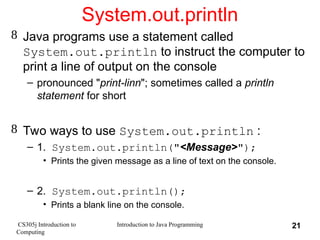
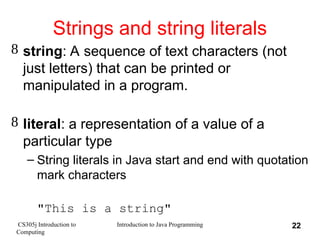

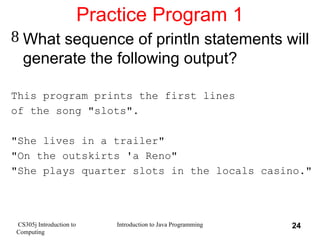


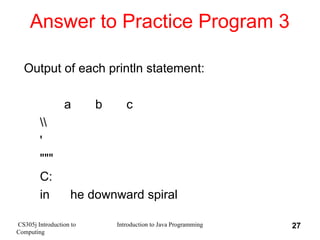




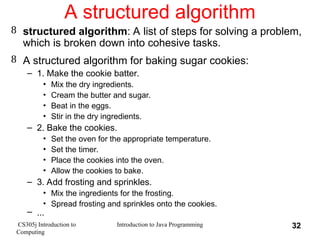



![CS305j Introduction to
Computing
Introduction to Java Programming 36
Static methods example
public class TwoMessages {
public static void main(String[] args) {
printCheer();
System.out.println();
printCheer();
}
public static void printCheer() {
System.out.println(“Three cheers for Pirates!");
System.out.println(“Huzzah!");
System.out.println(“Huzzah!");
System.out.println(“Huzzah!");
}
}
Program's output:
Three cheers for Pirates!
Huzzah!
Huzzah!
Huzzah!
Three cheers for Pirates!
Huzzah!
Huzzah!
Huzzah!](https://image.slidesharecdn.com/topic2introductiontojavaprogramming-250208040731-d6f4ff4a/85/Topic2IntroductionToJavaProgramming-with-concepts-36-320.jpg)
![CS305j Introduction to
Computing
Introduction to Java Programming 37
Methods calling each other
One static method may call another:
public class TwelveDays {
public static void main(String[] args) {
day1();
day2();
}
public static void day1() {
System.out.println("A partridge in a pear tree.");
}
public static void day2() {
System.out.println("Two turtle doves, and");
day1();
}
}
Program's output:
A partridge in a pear tree.
Two turtle doves, and
A partridge in a pear tree.](https://image.slidesharecdn.com/topic2introductiontojavaprogramming-250208040731-d6f4ff4a/85/Topic2IntroductionToJavaProgramming-with-concepts-37-320.jpg)
![CS305j Introduction to
Computing
Introduction to Java Programming 38
Control flow of methods
When a method is called, a Java program 'jumps'
into that method, executes all of its statements, and
then 'jumps' back to where it started.
public class TwelveDays {
public static void main(String[] args) {
day1();
day2();
}
}
public static void day1() {
System.out.println("A partridge in a pear tree.");
}
public static void day2() {
System.out.println("Two turtle doves, and");
day1();
}](https://image.slidesharecdn.com/topic2introductiontojavaprogramming-250208040731-d6f4ff4a/85/Topic2IntroductionToJavaProgramming-with-concepts-38-320.jpg)
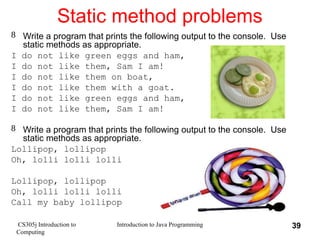






![CS305j Introduction to
Computing
Introduction to Java Programming 46
Comments example
/* Olivia Scott
CS 305j, Fall 2006
This program prints lyrics from a song! */
public class PartOfSong {
/* Runs the overall program to print the song
on the console. */
public static void main(String[] args) {
displayVerse();
// Separate the two verses with a blank line
System.out.println();
displayVerse();
}
// Displays the first verse of song.
public static void displayVerse() {
System.out.println("The road goes on forever,");
System.out.println("And the party never ends!");
}
}](https://image.slidesharecdn.com/topic2introductiontojavaprogramming-250208040731-d6f4ff4a/85/Topic2IntroductionToJavaProgramming-with-concepts-46-320.jpg)
















































